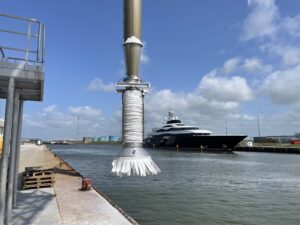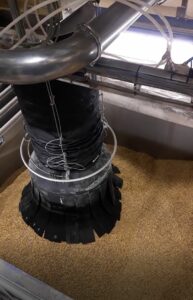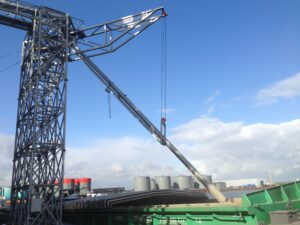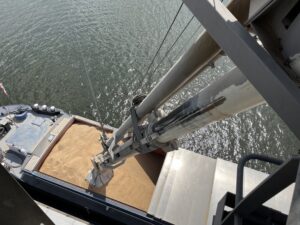Dust emissions during ship loading are often a burden on the environment. Unfortunately, it is not possible to load ships completely dust-free. However, it is possible to minimise dust emissions by fairly simple means.
Text from Bulk Guide – ‘Port storage and transhipment 2023’
When loading ships, product flows down a loading pipe from a great height and gains a lot of speed. When the material flow collides with the product mountain in the ship’s hold, a lot of energy is released. This leads to violent movement of the material, which can stir up a lot of dust.
The loading pipe (or loading conveyor) is often telescopic and pivoting, in order to load the vessel as efficiently as possible. Sometimes a dump pipe is used, equipped with a loading bellows at the end. To minimise dust generation, two basic solutions are possible, which can also be applied in combination:
- A sealing of the product surface and possible extraction.
- A speed reduction of the material flow from the loading pipe.
Reducing dust emissions with dust skirt
An example of closure is the deployment of a dust skirt under the spout. An automatic height adjustment ensures that the skirt rests on the product surface. A well-designed dust skirt is very effective, especially when moving vertically. Horizontal movements should be limited as much as possible or done in small increments, to keep the connection to the product surface intact. In practice, this is where things sometimes go wrong. A dust extraction has an effect, but this is completely lost if the seal is not good enough.
Reducing product speed with rotary valve or flap
The speed of the material flow at the end of the loading pipe can be reduced in various ways. A rotary valve removes all speed from the material flow and is therefore very effective. Another possibility is to use a sliding valve controlled by sensors, so that there is always a layer of product on the slide. The product then falls almost without speed. It is important, however, that the valve responds quickly enough in case of strongly fluctuating flow rates. A third, simple option is a cascade valve. This also inhibits the product, but is less effective than the rotary or sliding valve.
Custom solutions
Jansen&Heuning specialises in dust-free ship loading. We have created tailor-made solutions for various customers. Because we work with our own engineering, production and assembly departments, we can quickly and accurately design, test and, where necessary, optimise a suitable solution. Would you like to know more? Get in touch.











